语言学与翻译学第4..revised
- 格式:pptx
- 大小:115.72 KB
- 文档页数:20
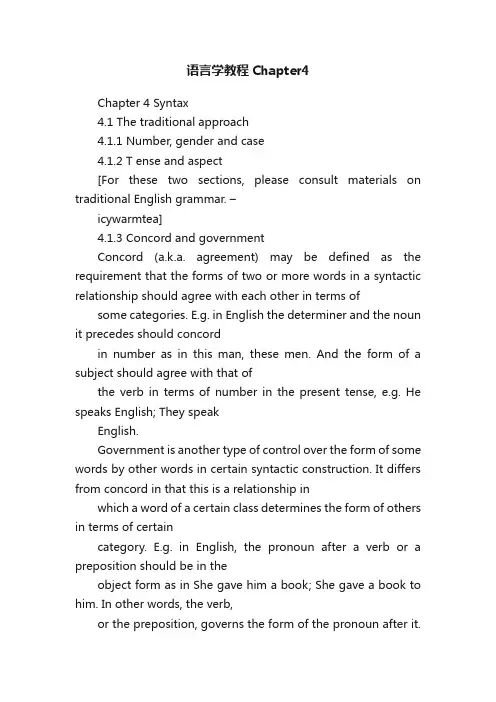
语言学教程Chapter4Chapter 4 Syntax4.1 The traditional approach4.1.1 Number, gender and case4.1.2 T ense and aspect[For these two sections, please consult materials on traditional English grammar. –icywarmtea]4.1.3 Concord and governmentConcord (a.k.a. agreement) may be defined as the requirement that the forms of two or more words in a syntactic relationship should agree with each other in terms of some categories. E.g. in English the determiner and the noun it precedes should concordin number as in this man, these men. And the form of a subject should agree with that ofthe verb in terms of number in the present tense, e.g. He speaks English; They speakEnglish.Government is another type of control over the form of some words by other words in certain syntactic construction. It differs from concord in that this is a relationship inwhich a word of a certain class determines the form of others in terms of certaincategory. E.g. in English, the pronoun after a verb or a preposition should be in theobject form as in She gave him a book; She gave a book to him. In other words, the verb,or the preposition, governs the form of the pronoun after it.The former is the governor,and the latter is the governed.4.2 The structural approach4.2.1 Syntagmatic and paradigmatic relationsSyntagmatic (a.k.a. horizontal / chain) relation is a relation between one item and others in a sequence, or between elements which are all present, such as the relationbetween weather and the others in the following sentence: If the weather is nice, we’llgo out.Paradigmatic (a.k.a. vertical / choice) relation is a relation holding between elements replaceable with each other at a particular place in a structure, or between oneelement present and the others absent.4.2.2 Immediate constituent analysis (IC analysis)1. How to do itImmediate constituents are constituents immediately, directly, below the level of a construction, which may be a sentence or a word group or a word.Immediate constituent analysis, IC analysis for short, refers to the analysis of asentence in terms of its immediate constituents –word groups (phrases), which are in turn analyzed into the immediate constituents of their own, and the process goes on until the ultimate sake of convenience. The IC analysis of a sentence may be carried out with brackets or shown with a tree diagram. E.g.Poor John ran away. →(1) ((Poor) (John)) ((ran) (away)).(2)2. Its advantagesThrough IC analysis, the internal structure of a sentence may be demonstrated clearly, any ambiguities, if any, will be revealed in that IC analysis emphasizes not only the linear structure of the sentence but also the hierarchical structure of the sentence.E.g. the sentence Leave the book on the shelf. is ambiguous. It has two meanings: (1)Put the book on the shelf; (2) Don’t touch the book on the shelf. These two meanings can be shown by the following tree diagrams. (Omitted. See the textbook p125~128.)3. Its problemsHowever, IC analysis has three disadvantages. First, at the beginning, some advocator insisted on binary divisions. Any construction, at any level, will be cut into two parts. But this is not possible. E.g. Old men and women is ambiguous in that it may me an old + men and women or old men + and women. It’s impossible to combine with only the preceding part or only the succeeding part. Second, constructions with discontinuous constituents will pose technical problems for tree diagrams in IC analysis.E.g. the phrasal verbs like make up, turn on, or give up will cause problems in that whenthe object is expressed by a pronoun, it will interrupt the phrasal verb as in make it up.The most serious problem is that there are structural ambiguities which cannot be revealed by IC analysis. E.g. the tree diagram and the labels can only do one analysis for the love of God.4.2.3 Endocentric and exocentric constructionsAn endocentric construction is one whose distribution is functionally equivalent, or approaching equivalence, to one of its constituents, which serves as the center, or head, of the whole. It is also called headed construction. Typical endocentric constructions are noun phrases, verb phrases and adjective phrases. They may be further divided into two subtypes: subordinate and coordinate constructions. Those, in which there is only one head, with the head being dominant and the other constructions dependent, are subordinate constructions. In the coordinate construction, there are more than one head,e.g. boys and girls, in which the two content constituents, boys and girls, are of equalsyntactic status, and no one is dependent on the other.The exocentric construction is defined negatively as a construction whose distribution is not functionally equivalent to any of its constituents. There is no noticeable center or head in it. Typical exocentric constructions are prepositional phrases, subordinate clauses, English basic sentences, and the verb plus object constructions.4. The behavioral process (a process of behavioring): physiological andpsychological behavior.5. The verbal process (a process of saying): any kinds of symbolic exchange ofmeaning.6. The existential process (a process of happening): a representation ofsomething in existence or happening/These six processes form a circle as follows: (omitted. Seetextbook, p.155)。
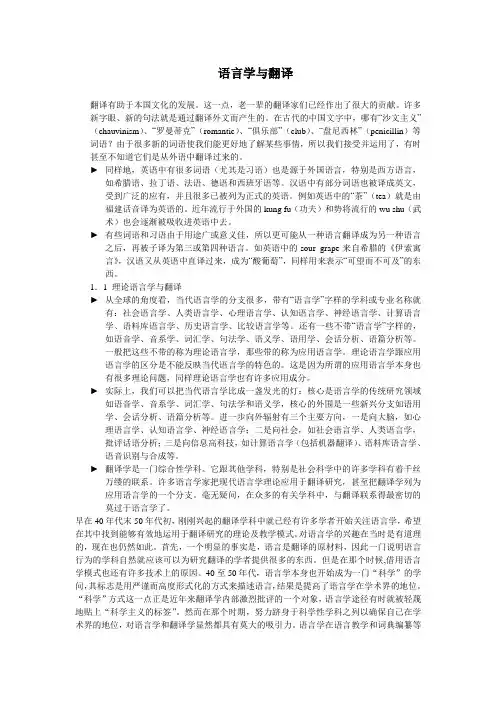
语言学与翻译翻译有助于本国文化的发展。
这一点,老一辈的翻译家们已经作出了很大的贡献。
许多新字眼、新的句法就是通过翻译外文而产生的。
在古代的中国文字中,哪有“沙文主义”(chauvinism)、“罗曼蒂克”(romantic)、“俱乐部”(club)、“盘尼西林”(penicillin)等词语?由于很多新的词语使我们能更好地了解某些事情,所以我们接受并运用了,有时甚至不知道它们是从外语中翻译过来的。
►同样地,英语中有很多词语(尤其是习语)也是源于外国语言,特别是西方语言,如希腊语、拉丁语、法语、德语和西班牙语等。
汉语中有部分词语也被译成英文,受到广泛的应有,并且很多已被列为正式的英语。
例如英语中的“茶”(tea)就是由福建话音译为英语的。
近年流行于外国的kung fu(功夫)和势将流行的wu shu(武术)也会逐渐被吸收进英语中去。
►有些词语和习语由于用途广或意义佳,所以更可能从一种语言翻译成为另一种语言之后,再被子译为第三或第四种语言。
如英语中的sour grape来自希腊的《伊索寓言》,汉语又从英语中直译过来,成为“酸葡萄”,同样用来表示“可望而不可及”的东西。
1.1 理论语言学与翻译►从全球的角度看,当代语言学的分支很多,带有“语言学”字样的学科或专业名称就有:社会语言学、人类语言学、心理语言学、认知语言学、神经语言学、计算语言学、语料库语言学、历史语言学、比较语言学等。
还有一些不带“语言学”字样的,如语音学、音系学、词汇学、句法学、语义学、语用学、会话分析、语篇分析等。
一般把这些不带的称为理论语言学,那些带的称为应用语言学。
理论语言学跟应用语言学的区分是不能反映当代语言学的特色的。
这是因为所谓的应用语言学本身也有很多理论问题,同样理论语言学也有许多应用成分。
►实际上,我们可以把当代语言学比成一盏发光的灯:核心是语言学的传统研究领域如语音学、音系学、词汇学、句法学和语义学,核心的外围是一些新兴分支如语用学、会话分析、语篇分析等。
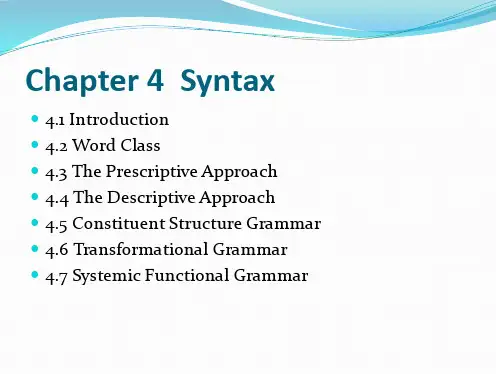
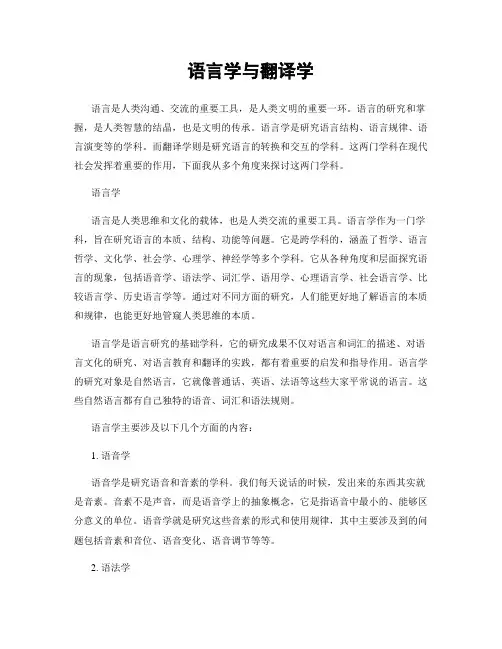
语言学与翻译学语言是人类沟通、交流的重要工具,是人类文明的重要一环。
语言的研究和掌握,是人类智慧的结晶,也是文明的传承。
语言学是研究语言结构、语言规律、语言演变等的学科。
而翻译学则是研究语言的转换和交互的学科。
这两门学科在现代社会发挥着重要的作用,下面我从多个角度来探讨这两门学科。
语言学语言是人类思维和文化的载体,也是人类交流的重要工具。
语言学作为一门学科,旨在研究语言的本质、结构、功能等问题。
它是跨学科的,涵盖了哲学、语言哲学、文化学、社会学、心理学、神经学等多个学科。
它从各种角度和层面探究语言的现象,包括语音学、语法学、词汇学、语用学、心理语言学、社会语言学、比较语言学、历史语言学等。
通过对不同方面的研究,人们能更好地了解语言的本质和规律,也能更好地管窥人类思维的本质。
语言学是语言研究的基础学科,它的研究成果不仅对语言和词汇的描述、对语言文化的研究、对语言教育和翻译的实践,都有着重要的启发和指导作用。
语言学的研究对象是自然语言,它就像普通话、英语、法语等这些大家平常说的语言。
这些自然语言都有自己独特的语音、词汇和语法规则。
语言学主要涉及以下几个方面的内容:1. 语音学语音学是研究语音和音素的学科。
我们每天说话的时候,发出来的东西其实就是音素。
音素不是声音,而是语音学上的抽象概念,它是指语音中最小的、能够区分意义的单位。
语音学就是研究这些音素的形式和使用规律,其中主要涉及到的问题包括音素和音位、语音变化、语音调节等等。
2. 语法学语法学是研究语言形式的学科。
它主要研究语言的词法和句法规则。
在词法方面,语法学研究的是单词的词性、屈折和构词规则;在句法方面,它研究的是句子结构和句型、句子成分、句法中心和句法关系等问题。
语法学对人学习语言,尤其是第二语言习得有着重要的意义。
3. 词汇学词汇学是研究词汇的学科。
它涉及到的问题包括词的定义、类别、形态、用法和意义等。
词汇学家研究词汇的好处是了解一个语言丰富多样的词汇以及不同语言之间的字根、前缀、后缀等等变化规则。
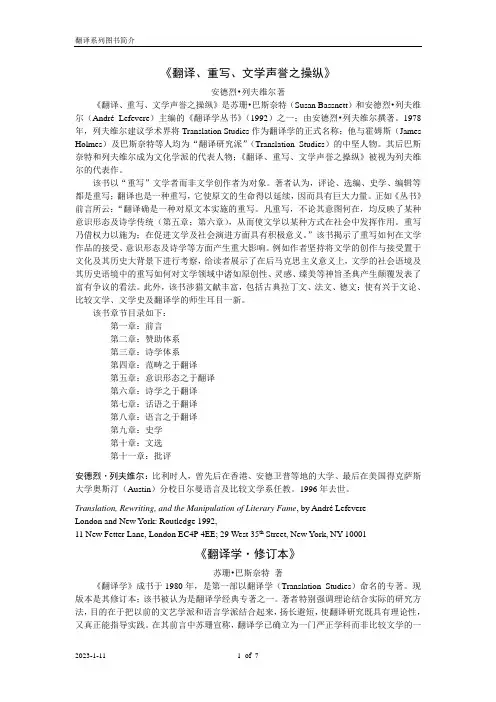
《翻译、重写、文学声誉之操纵》安德烈•列夫维尔著《翻译、重写、文学声誉之操纵》是苏珊•巴斯奈特(Susan Bassnett)和安德烈•列夫维尔(AndréLefevere)主编的《翻译学丛书》(1992)之一;由安德烈•列夫维尔撰著。
1978年,列夫维尔建议学术界将Translation Studies作为翻译学的正式名称;他与霍姆斯(James Holmes)及巴斯奈特等人均为“翻译研究派”(Translation Studies)的中坚人物。
其后巴斯奈特和列夫维尔成为文化学派的代表人物;《翻译、重写、文学声誉之操纵》被视为列夫维尔的代表作。
该书以“重写”文学者而非文学创作者为对象。
著者认为,评论、选编、史学、编辑等都是重写;翻译也是一种重写,它使原文的生命得以延续,因而具有巨大力量。
正如《丛书》前言所云:“翻译确是一种对原文本实施的重写。
凡重写,不论其意图何在,均反映了某种意识形态及诗学传统(第五章;第六章),从而使文学以某种方式在社会中发挥作用。
重写乃借权力以施为;在促进文学及社会演进方面具有积极意义。
”该书揭示了重写如何在文学作品的接受、意识形态及诗学等方面产生重大影响。
例如作者坚持将文学的创作与接受置于文化及其历史大背景下进行考察,给读者展示了在后马克思主义意义上,文学的社会语境及其历史语境中的重写如何对文学领域中诸如原创性、灵感、臻美等神旨圣典产生颠覆发表了富有争议的看法。
此外,该书涉猎文献丰富,包括古典拉丁文、法文、德文;使有兴于文论、比较文学、文学史及翻译学的师生耳目一新。
该书章节目录如下:第一章:前言第二章:赞助体系第三章:诗学体系第四章:范畴之于翻译第五章:意识形态之于翻译第六章:诗学之于翻译第七章:话语之于翻译第八章:语言之于翻译第九章:史学第十章:文选第十一章:批评安德烈·列夫维尔:比利时人,曾先后在香港、安德卫普等地的大学、最后在美国得克萨斯大学奥斯汀(Austin)分校日尔曼语言及比较文学系任教。
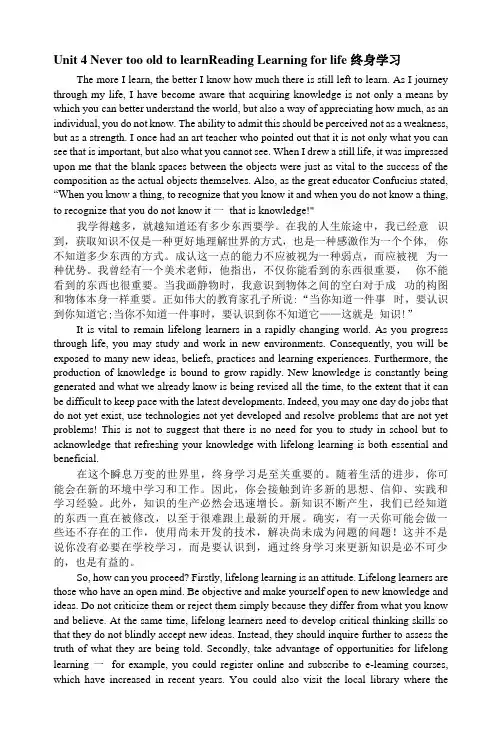
Unit 4 Never too old to learnReading Learning for life 终身学习The more I learn, the better I know how much there is still left to learn. As I journey through my life, I have become aware that acquiring knowledge is not only a means by which you can better understand the world, but also a way of appreciating how much, as an individual, you do not know. The ability to admit this should be perceived not as a weakness, but as a strength. I once had an art teacher who pointed out that it is not only what you can see that is important, but also what you cannot see. When I drew a still life, it was impressed upon me that the blank spaces between the objects were just as vital to the success of the composition as the actual objects themselves. Also, as the great educator Confucius stated, “When you know a thing, to recognize t hat you know it and when you do not know a thing, to recognize that you do not know it 一that is knowledge!"我学得越多,就越知道还有多少东西要学。
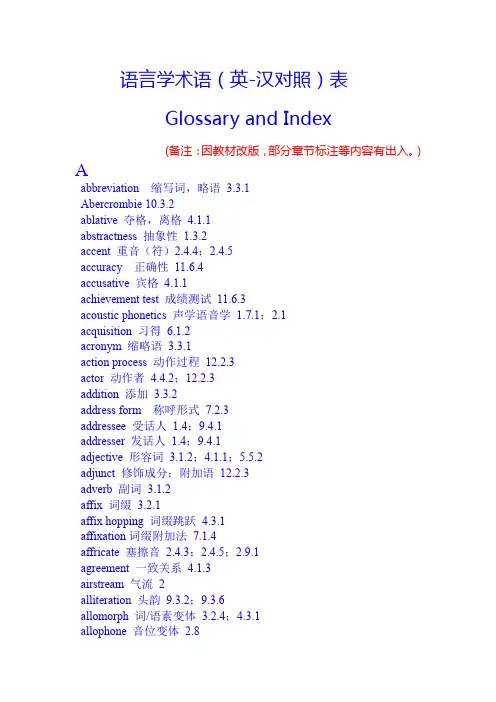
语言学术语(英-汉对照)表Glossary and Index(备注:因教材改版,部分章节标注等内容有出入。
) Aabbreviation 缩写词,略语3.3.1Abercrombie 10.3.2ablative 夺格,离格4.1.1abstractness 抽象性1.3.2accent 重音(符)2.4.4;2.4.5accuracy 正确性11.6.4accusative 宾格4.1.1achievement test 成绩测试11.6.3acoustic phonetics 声学语音学1.7.1;2.1acquisition 习得6.1.2acronym 缩略语3.3.1action process 动作过程12.2.3actor 动作者4.4.2;12.2.3addition 添加3.3.2address form 称呼形式7.2.3addressee 受话人1.4;9.4.1addresser 发话人1.4;9.4.1adjective 形容词3.1.2;4.1.1;5.5.2adjunct 修饰成分;附加语12.2.3adverb 副词3.1.2affix 词缀3.2.1affix hopping 词缀跳跃4.3.1affixation词缀附加法7.1.4affricate 塞擦音2.4.3;2.4.5;2.9.1agreement 一致关系4.1.3airstream 气流2alliteration 头韵9.3.2;9.3.6allomorph 词/语素变体3.2.4;4.3.1allophone 音位变体2.8allophonic variation 音位变体2.8.3allophony音位变体现象2.8.3alveolar ridge 齿龈2.2alveolar 齿龈音2.4.4;2.4.5ambiguity 歧义4.2.2;4.3.1;6.2.3;8.2.2;8.3.2 ambiguous歧义的5.5.2;6.3American descriptive linguistics 美国描写语言学12.3 American English 美式英语10.3.5American Indian languages 美国印第安族诸语言12.3 American structuralism 美国结构主义10.3.2;12.3 analogical creation 类推造字3.3.1anapest 抑抑扬格9.3.3anaphor 前指替代4.3.3anaphoric reference 前指照应4.3.2Anderson 6.3.1Animal communication system 动物交际系统1.2;1.3 animate 有生命的4.2.1annotation 注解10.3.4;10.3.5antecedent 先行词;前在词4.3.2anthropological 人类学的12.3.1anthropological linguistics 人类语言学1.8.3;7.1.1 anticipatory coarticulation 逆化协同发音2.6.1 antonomasia 换称;代类名7.1.4antonym 反义词5.4antonymy 反义(关系) 5.3.2appellative 称谓性4.4.2applied linguistics 应用语言学11applied sociolinguistics 应用社会语言学7.2.4 appropriacy 适宜性11.6.4appropriateness 适宜性;得体性11.2.5 approximant 无摩擦延续音2.4.3;2.4.5Apte 7;7.2.1aptitude test 素质测试11.6.2Arabic 阿拉伯语3.3.1;4.4.1arbitrariness 任意性1.3.1;12argument 中项;中词;主目4.3.3;5.5.2article 冠词3.1.2;4.1.1;4.2.1articulation 发音2.6articulator 发音器官2.4.2;2.4.3articulatory phonetics 发音语音学1.7.1;2.1 artificial speech 人工言语10aspect 体4.1.2aspirated 吐气;送气2.6.2;2.8.2 assimilation 同化2.9.1;3.2.4;3.3.2;6.2.4 associative 联想4.2.1associative meaning 联想意义5.3 assonance 准压韵;半谐音9.3.2;9.3.6 Atkinson, A.M. 2.1attributive 属性;修饰语;定语4.2.2;12.2.3 auditory phonetics 听觉语音学1.7.1;2.1 Austin, John Langshaw 8.1;8.1.2authentic input 真实投入11.4.2authorial style 权威风格9.4.3authoring program 编程10.1.3autonomy 自主性1.8auxiliary 助词3.1.2;12.4.3auxiliary verb 助动词3.1.2;12.2.3Bbabbling stage 婴儿语阶段12.4.1back-formation 逆构词法3.3.1Bally, Charles 9.1Bar-Hillel 10.2.1Barnhart & Barnhart 7.1.4base component 基础部分4.3.2;12.4。
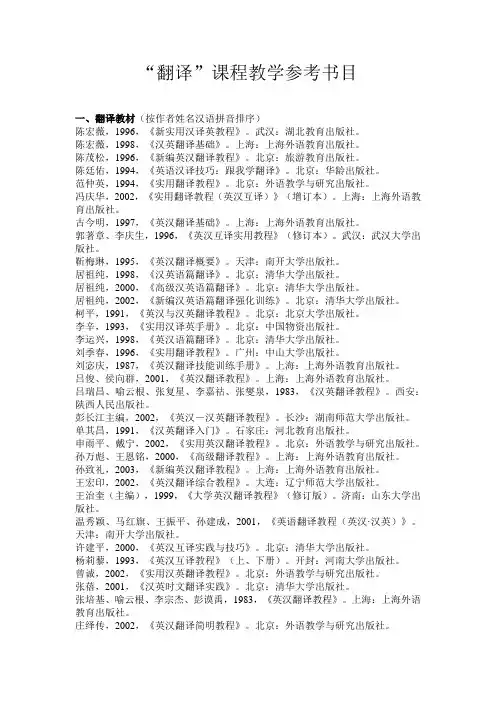
“翻译”课程教学参考书目一、翻译教材(按作者姓名汉语拼音排序)陈宏薇,1996,《新实用汉译英教程》。
武汉:湖北教育出版社。
陈宏薇,1998,《汉英翻译基础》。
上海:上海外语教育出版社。
陈茂松,1996,《新编英汉翻译教程》。
北京:旅游教育出版社。
陈廷佑,1994,《英语汉译技巧:跟我学翻译》。
北京:华龄出版社。
范仲英,1994,《实用翻译教程》。
北京:外语教学与研究出版社。
冯庆华,2002,《实用翻译教程(英汉互译)》(增订本)。
上海:上海外语教育出版社。
古今明,1997,《英汉翻译基础》。
上海:上海外语教育出版社。
郭著章、李庆生,1996,《英汉互译实用教程》(修订本)。
武汉:武汉大学出版社。
靳梅琳,1995,《英汉翻译概要》。
天津:南开大学出版社。
居祖纯,1998,《汉英语篇翻译》。
北京:清华大学出版社。
居祖纯,2000,《高级汉英语篇翻译》。
北京:清华大学出版社。
居祖纯,2002,《新编汉英语篇翻译强化训练》。
北京:清华大学出版社。
柯平,1991,《英汉与汉英翻译教程》。
北京:北京大学出版社。
李辛,1993,《实用汉译英手册》。
北京:中国物资出版社。
李运兴,1998,《英汉语篇翻译》。
北京:清华大学出版社。
刘季春,1996,《实用翻译教程》。
广州:中山大学出版社。
刘宓庆,1987,《英汉翻译技能训练手册》。
上海:上海外语教育出版社。
吕俊、侯向群,2001,《英汉翻译教程》。
上海:上海外语教育出版社。
吕瑞昌、喻云根、张复星、李嘉祜、张燮泉,1983,《汉英翻译教程》。
西安:陕西人民出版社。
彭长江主编,2002,《英汉-汉英翻译教程》。
长沙:湖南师范大学出版社。
单其昌,1991,《汉英翻译入门》。
石家庄:河北教育出版社。
申雨平、戴宁,2002,《实用英汉翻译教程》。
北京:外语教学与研究出版社。
孙万彪、王恩铭,2000,《高级翻译教程》。
上海:上海外语教育出版社。
孙致礼,2003,《新编英汉翻译教程》。
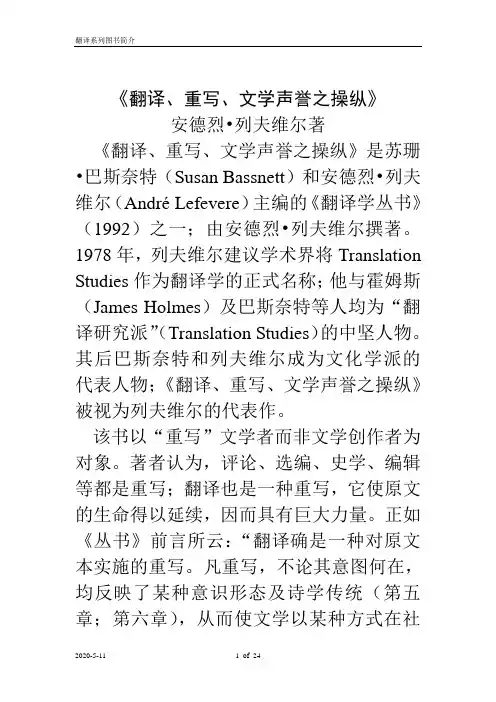
《翻译、重写、文学声誉之操纵》安德烈•列夫维尔著《翻译、重写、文学声誉之操纵》是苏珊•巴斯奈特(Susan Bassnett)和安德烈•列夫维尔(André Lefevere)主编的《翻译学丛书》(1992)之一;由安德烈•列夫维尔撰著。
1978年,列夫维尔建议学术界将Translation Studies作为翻译学的正式名称;他与霍姆斯(James Holmes)及巴斯奈特等人均为“翻译研究派”(Translation Studies)的中坚人物。
其后巴斯奈特和列夫维尔成为文化学派的代表人物;《翻译、重写、文学声誉之操纵》被视为列夫维尔的代表作。
该书以“重写”文学者而非文学创作者为对象。
著者认为,评论、选编、史学、编辑等都是重写;翻译也是一种重写,它使原文的生命得以延续,因而具有巨大力量。
正如《丛书》前言所云:“翻译确是一种对原文本实施的重写。
凡重写,不论其意图何在,均反映了某种意识形态及诗学传统(第五章;第六章),从而使文学以某种方式在社会中发挥作用。
重写乃借权力以施为;在促进文学及社会演进方面具有积极意义。
”该书揭示了重写如何在文学作品的接受、意识形态及诗学等方面产生重大影响。
例如作者坚持将文学的创作与接受置于文化及其历史大背景下进行考察,给读者展示了在后马克思主义意义上,文学的社会语境及其历史语境中的重写如何对文学领域中诸如原创性、灵感、臻美等神旨圣典产生颠覆发表了富有争议的看法。
此外,该书涉猎文献丰富,包括古典拉丁文、法文、德文;使有兴于文论、比较文学、文学史及翻译学的师生耳目一新。
该书章节目录如下:第一章:前言第二章:赞助体系第三章:诗学体系第四章:范畴之于翻译第五章:意识形态之于翻译第六章:诗学之于翻译第七章:话语之于翻译第八章:语言之于翻译第九章:史学第十章:文选第十一章:批评安德烈·列夫维尔:比利时人,曾先后在香港、安德卫普等地的大学、最后在美国得克萨斯大学奥斯汀(Austin)分校日尔曼语言及比较文学系任教。

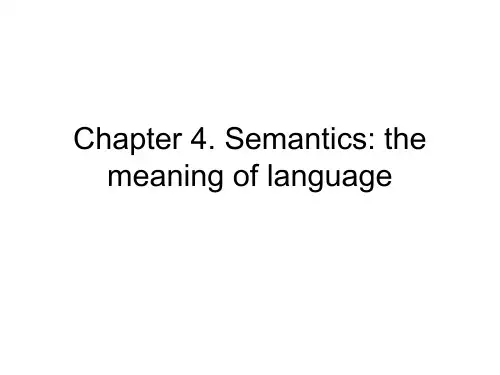
《翻译、重写、文学声誉之操纵》安德烈•列夫维尔著《翻译、重写、文学声誉之操纵》是苏珊•巴斯奈特(Susan Bassnett)和安德烈•列夫维尔(André Lefevere)主编的《翻译学丛书》(1992)之一;由安德烈•列夫维尔撰著。
1978年,列夫维尔建议学术界将Translation Studies作为翻译学的正式名称;他与霍姆斯(James Holmes)及巴斯奈特等人均为“翻译研究派”(Translation Studies)的中坚人物。
其后巴斯奈特和列夫维尔成为文化学派的代表人物;《翻译、重写、文学声誉之操纵》被视为列夫维尔的代表作。
该书以“重写”文学者而非文学创作者为对象。
著者认为,评论、选编、史学、编辑等都是重写;翻译也是一种重写,它使原文的生命得以延续,因而具有巨大力量。
正如《丛书》前言所云:“翻译确是一种对原文本实施的重写。
凡重写,不论其意图何在,均反映了某种意识形态及诗学传统(第五章;第六章),从而使文学以某种方式在社会中发挥作用。
重写乃借权力以施为;在促进文学及社会演进方面具有积极意义。
”该书揭示了重写如何在文学作品的接受、意识形态及诗学等方面产生重大影响。
例如作者坚持将文学的创作与接受置于文化及其历史大背景下进行考察,给读者展示了在后马克思主义意义上,文学的社会语境及其历史语境中的重写如何对文学领域中诸如原创性、灵感、臻美等神旨圣典产生颠覆发表了富有争议的看法。
此外,该书涉猎文献丰富,包括古典拉丁文、法文、德文;使有兴于文论、比较文学、文学史及翻译学的师生耳目一新。
该书章节目录如下:第一章:前言第二章:赞助体系第三章:诗学体系第四章:范畴之于翻译第五章:意识形态之于翻译第六章:诗学之于翻译第七章:话语之于翻译第八章:语言之于翻译第九章:史学第十章:文选第十一章:批评安德烈·列夫维尔:比利时人,曾先后在香港、安德卫普等地的大学、最后在美国得克萨斯大学奥斯汀(Austin)分校日尔曼语言及比较文学系任教。
Some Basic Concepts of TranslationI.Some controversial issues:1.literal translation vs. free translation 直译还是意译2.functional equivalence vs. formal correspondence 功能对等还是形式对应3.content vs. form 重内容还是重形式4.source-oriented vs. target-oriented 靠近原语还是靠近译入语5.author-centered vs. reader-centered 以原作者为中心还是以译入语读者为中心6.the purpose of the author vs. the purpose of the translator 原作者写作的目的还是译者翻译的目的II.THE METHODS(Peter Newmark)1. Word-for-word translation (逐字翻译)This is often demonstrated as interlinear translation, with the TL immediately below the SL words. The SL word-order is preserved and the words translated singly by their most common meanings, out of context. Cultural words are translated literally. The main use of word-for-word translation is either to understand the mechanics of the source language or to construe a difficult text as a pre-translation process.2. Literal translation (直译)The SL grammatical constructions are converted to their nearest TL equivalents but the lexical words are again translated singly, out of context. As a pre-translation process, this indicates the problems to be solved.3. Faithful translation (忠实翻译)A faithful translation attempts to reproduce the precise contextual meaning of the original within the constraints of the TL grammatical structures. It …transfers‟cultural words and preserves the degree of grammatical and lexical …abnormality‟ (deviation from SL norms) in the translation. It attempts to be completely faithful to the intentions and the text-realisation of the SL writer.4. Semantic translation (语义翻译)Semantic translation differs from …faithful translation‟only in as far as it must take more account of the aesthetic value (that is, the beautiful and natural sound) of the SL text, compromising on …meaning‟where appropriate so that no assonance, word-play or repetition jars in the finished version. Further, it may translate less important cultural words by culturally neutral third or functional terms but not by cultural equivalents-une nonne repassant un corporal may become …a nun ironing a corporal cloth‟–and it may make other small concessions to the readership. The distinction between …faithful‟and …semantic‟translation is that the first is uncompromising and dogmatic, while the second is more flexible, admits the creative exception to 100% fidelity and allows for the translator‟s intuitive empathy with the original.5. Adaptation (改写)This is the …freest‟ form of translation. It is used mainly for plays (comedies) and poetry; the themes, characters, plots are usually preserved, the SL culture converted to the TL culture and the text rewritten. The deplorable practice of having a play or poem literally translated and then rewritten by an established dramatist or poet has produced many poor adaptations, but other adaptations have …rescued‟ period plays.6. Free translation (自由翻译)Free translation reproduces the mater without the manner, or the content without the form of the original. Usually it is a paraphrase much longer than the original, a so-called …intralingual translation‟, often prolix and pretentious, and not translation at all.7. Idiomatic translation (习语翻译)Idiomatic translation reproduces the …message‟of the original but tends to distort nuances of meaning by preferring colloquialisms and idioms where these do not exist in the original. (Authorities as diverse as Seleskovitch and Stuart Gilbert tend to this form of lively, …natural‟translation.8. Communicative translation (交流翻译)Communicative translation attempts to render the exact contextual meaning of the original in such a way that both content and language are readily acceptable and comprehensible to the readership.III.The nature of translating(Nida)“Translating consists in reproducing in the receptor language the closest natural equivalent of the source-language message, first in terms of meaning and secondly in terms of style.”1.Reproducing the messageTranslating must aim primarily at “reproducing the message”. To do anything else is essentially false to one‟s task as a translator. But to reproduce the message one must make a good many grammatical and lexical adjustments.2.Equivalence rather than identityThe translator must strive for equivalence rather than identity. In a sense, this is just another way of emphasizing the reproduction of the message rather than the conservation of the form of the utterance.3. A natural equivalentThe best translation does not sound like a translation. That is to say, it should studiously avoid “translationese”—formal fidelity, with resulting unfaithfulness to the contentand the impact of the message.4.The closest equivalentA conscientious translator will want the closest natural equivalent. It has been argued ,for example, that in present-day English a natural equivalent of “demon-possessed”would be “ mentally distressed.” This might be regarded by some as a natural equivalent, but it is certainly not the “closest equivalent”.5.The priority of meaningAs it has already been indicated in the definition of translating, meaning must be given priority, for it is the content of the message which is of prime importance for translating.This means that certain rather radical departures from the formal structure are not only legitimate but may even be highly desirable.6.The significance of styleThough style is secondary to content, it is nevertheless important. One should not translate poetry as though it were prose, nor expository material as though it were straight narrative. …It is usually quite impossible to represent some of the stylistic subtleties of the original.IV. Language Functions, Text-categories and Text-types(Peter Newmark)Three main functions:1.The expressive function (表达功能)The core of the expressive function is the mind of the speaker, the writer, the originator of the utterance. He uses the utterance to express his feelings irrespective of any response.The characteristic …expressive‟ text-types are:1)Serious imaginative literature: lyrical poetry, short stories, novels, plays.2)Authoritative statements: political speeches, documents etc; statutes and legaldocuments; scientific, philosophical and …academic‟ works written by acknowledgedauthorities.3)Autobiography, essays, personal correspondence.2.The informative function (信息功能)The core of informative function of language is external situation, the facts of a topic, reality outside language, including reported ideas or theories.Typical …informative‟ texts are concerned with any topic of knowledge, but texts about literary subjects, as they often express value-judgments, are apt to lean towards …expressiveness‟. The format of an informative text is often standard: a textbook, atechnical report, an article in a newspaper or a periodical, a scientific paper, a thesis, minutes or agenda of a meeting.3.The vocative function (呼唤功能)The core of the vocative function of language is the readership, the addressee. The term …vocative‟ is used in the sense of …calling upon‟ the readership to act, think or feel, in fact to …react‟ in the way intended by the text.We take notices, instructions, publicity, propaganda, persuasive writing and possibly popular fiction, whose purpose is to sell the book/entertain the reader, as the typical …vocative‟ text.However, few texts are purely expressive, informative or vocative: most include all three functions, with an emphasis on one of the three.V. Koller (1979) proposes a checklist for translationally relevant text analysis under the headings of:1. language fuction;2. content characteristics;3. language-stylistic characteristics;4. formal-aesthetic characteristics;6. pragmatic characteristisVI. Tytler’s three general ‘laws’ or ‘rules’ for translation(1797)1. The translation should give a complete transcript of the ideas of the original work.2. The style and manner of writing should be of the same character with that of theoriginal.3. The translation should have all the ease of the original composition.VII. Nida’s ‘four basic requirements of a translation’:1.making sense;2.conveying the spirit and manner of the original;3.having a natural and easy form of expression;4.producing a similar response.Naturalness is a key requirement for Nida.For Nida,the success of a translation depends above all on achieving equivalentresponse.Nida underlines that …correspondence in meaning must have priority overcorrespondence in style‟, if equivalent effect is to be achieved.IIX. Vinary and Darbelnet’s model(2000)The two strategies they identified (literal/free) comprise seven procedures, of which direct translation covers three:1.Borrowing: The SL word is transferred directly to the TL.2.Calque: This is a special kind of borrowing where the SL expression or structure istransferred in a literal translation. Eg. summit meeting <> 峰会3.Literal translation: This is a …word-for-word‟translation, which Vinary and Darbelnetdescribes as being most common between languages of the same family.4.Transposition: This is a change of one part of speech for another without changing thesense. Vinary and Darbelnet see transposition as the most “probably the most common structural change undertaken by translators”. They list at least ten categories, such as: verb to noun; adverb to verb ….5.Modulation: This changes the semantics and point of view of the SL. It can be:1)obligatory: e.g. “the time when”translates as “the moment where”in French (lemoment ou). “You‟ve had a narrow escape.”你真是死里逃生!2)optional: e.g. the reversal of point of view in “it is not difficult to show” translates as“显而易见”6.Equivalence: Vinary and Darbelnet use this term to refer to cases where languages describethe same situation by different stylistic or structural means. Equivalence is particularly useful in translating idioms and proverbs, e.g. as strong as a horse —> 壮如牛.7.Adaptation: This involves changing the cultural reference when a situation in the sourceculture does not exist in the target culture.IX. Polysystem TheoryA theory proposed by Even-Zohar to account for the behavior and evolution of literary SYSTEMS. The term denotes a stratified conglomerate (多层次的聚合) of interconnected elements, which changes and mutates (develop a new form) as these elements interact with each other.X. Other termsPragmatic translationA term used to refer to translation which pays attention not only to denotative meaning but also to “the way utterances are used in communicative situations and the way we interpret them in context.Receptor languageReceptor language is a term defined by Nida & Taber as “the language into which a message is translated from the source language.” It is basically synonymous with the term “target language.”Target languageTarget language is the standard term used to denote the language which is being translated into.Source languageSource language is the standard term describing the language in which the text being translated is written.InterpretingInterpreting is a term used to refer to the oral translation of a spoken message or text. Interpreting differs from translation in a number of important respects.1.The communication skills needed are clearly different. Interpreters need to be expert oralcommunicators.2.Interpreters are required to create a finished product in “real time” without the possibility ofgoing back and making revisions.3.Interpreters must ensure that any background knowledge which they are likely to need hasbeen acquired in advance.4.Interpreters are “performers” who are constantly making split-second decisions and takingcommunicative risks; consequently they typically experience higher stress levels while “on the job” than most translators.Relay interpretingRelay interpreting is a term used to refer to the practice of interpreting between two (usually less widely spoken) languages via a third.ShiftsThe term is originally defined by Catford as “departures from formal correspondence in the process of going from the SL to the TL” (1965:73). The shifts described by Catford are therefore purely linguistic, being grammatical or lexical in nature.Toury (1980, 1995) further developed the notion of shifts, distinguishing two varieties, the obligatory (e.g. linguistically motivated) and the non-obligatory (e.g. motivated by literary or cultural considerations); the extent to which a TT contains non-obligatory shifts will determine whether its INITIAL NORM is one of ACCEPYABILITY or ADEQUACY.CompensationCompensation is a term in general use for a number of decades, and defined by Hervey & Higgins as “the technique of making up for the translation loss of important ST features by approximating their effects in the TT through means other than those used in the ST” (1992:248).Corpora (singular Corpus)Corpora is a term traditionally used in translation studies to refer to relatively small–scale collections of texts, (parts of ) which are searched manually for examples of features which are of interest.CorrespondenceCorrespondence is a term used to refer to the relationship which exists between elements of SL and TL that are in some way considered to be counterparts of each other. Correspondence is usually presented as a somewhat weaker notion than the perhaps more frequently encountered concept of EQUIV ALENCE (Hermans 1991:157).。
英汉翻译讲解(1)I.英汉之间的差别:“对于中国学生最有用的帮助是让他认识英语和汉语的差别。
”------吕叔湘国内学者的共识是:汉语是综合性的,描写性的,而英语是分析性的,逻辑性的。
在语言学上最重要的区别在于形合和意合的对比(contrast between hypotaxis and parataxis),英语重形合(形式上的融合),汉语重意合(意思或意境的融合)。
在句法方面,有学者形象地把英汉比喻为以下几种:1.雄孔雀/雄狮-----即英语习惯于把最着重的事物放在句首先说出来,开门见山,一语破的,然后再把各种标志一条条补述,一步步交代,慢条斯理,从容不迫,形成一条头短尾长地线性链,象头小尾大地雄孔雀。
而汉语则相反,其线性序列的展开好比画龙点睛,先把外围的环境与衬托一一交代周到,最后点出话语的信息中心,水到渠成,给人以豁然开朗之感,形成雄狮型头大尾小地局式。
例如:I was all the more delighted when, as a result of the initiative of your Government it proved possible to reinstate the visit so quickly.译文:由于贵国政府的提议,才得以这样快地重新实现访问。
这使我感到特别高兴。
又如:The assertion that it was difficult, if not impossible, for a people to enjoy its basic rights unless it was able to determine freely its political status and to ensure freely its economic, social and cultural development was now scarcely (不足地,不充分地;一定不,绝不)contested (斗争;比赛).译文:如果一个民族不能自由地决定其政治地位,不能自由地保证其经济、社会和文化的发展,要享受其基本权利,即使不是不可能,也是不容易的。
语言学第四章要点(2011-10-11 21:15:48)说明:本章要点参考了多本教材,其中的X-bar theory, Universal Grammar, merger and move等部分仅供考研的同学参考。
其他同学不做要求。
第四章Syntax句法学1.Syntax定义is a subfield of linguistics that studies the sentence structure of language. Sentences are structured according to particular arrangement of words.2、Syntax as a system of rules. as a major component of grammar, syntax consists of a set of abstract rules that allow words to be combined with other words to form grammatical sentences3、Sentence structureSubject all language have ways of referring to some entity, such as a person , a place, a thing, an idea, or an event, this referring expression is grammatically called subject. A subject may be a noun or a noun phrase in a sentence that usually precedes the predicate.2.Type of sentence英语的句子中的三种基本类型是什么?Traditionally, three major types of sentences are distinguished. They are simple sentence, coordinate or compound sentence and complex sentence.A simple sentence consists of a single clause which contains a subject and a predicate and stands alone as its own sentence. For example, ① John reads extensively. the sentences contains a single clause and can stand structurally independent.A coordinate sentence并列句 contains two clauses joined by a linking word called coordinat ing conjunction, such as “and”, “but”, “or”. The two clauses in a coordinate sentence are structurally equal parts of the sentence; neither is subordinate to the other. For example, ③ John is reading a linguistic book, and Mary is preparing for her history exam.A complex sentence contains two or more clauses, one of which is incorporated into the other. The two clauses in a complex sentence have unequal status, one subordinating the other. The incorporated, or subordinate, clause is normally called an embedded clause子句, and the clause into which it is embedded is called a matrix sentence主句. For example, ⑤ Mary told Jane [that John liked linguistics]. In the above examples, the clauses in the square brackets are embedded clauses. Theyare subordinate to the clauses outside the brackets which are called matrix clauses.A complex sentence的特征:Some conclusions can be drawn from the complex sentence.1、an embedded clause functions as a grammatical unit in its matrix clause.2.most embedded clauses require an introductory word called a subordinator, such as “that”,” if ”.3.an embedded clause may not function as a grammatically well-formed sentence if it stands independently as a simple sentence unless it form changes.3、linearly- and hierarchically-structured.(线形结构和层次结构Language is a highly structured system of communication. Sentences are not formed by randomly(随意)combining lexical items, but by following a set of syntactic rules that arrange linguistic elements in a particular order to make a string of words not only meaningful but also linearly- and hierarchically-structured.(线形结构和层次结构)Hierarchical structure: the sentence structure that groups words into structural constituents and shows the syntactic categories of each structural constituent, such as NP and VP.5、Syntactic categories:句法类型1.lexical categories词类 (four major lexical categories and six minor lexical categories)2. Phrasal categories 短语类(lexical items have certain combinational properties that allow them to combine with words of different categories to form phrase. NP VP PP AP)6、Grammatical relations(语法关系) The structural and logical relations of constituents are called grammatical relations. It concerns the way each noun phrase in the sentence relates to the verb. (who does what do whom). Structural vs. logical subject, object. (**)7、Combinational rules组合规则1、Phrase structural rules The combinational pattern in a linear formula may be called a phrase structural rule, or rewrite rule. It allows us to better understand how words and phrases form sentences, and so on.2、Syntactic movement and movement rules Syntactic movement occurs whena constituent in a sentence moves out of its original place to a new position, the sentence involving which cannot be described by phrase structure rules. It was governed by transformational rules, the operationof which may change the syntactic representation of a sentence (句法的表达方式).3、什么是X-标杆理论?X-bar theory is a general and highly abstract schema that collapses all phrasal structure rules into a single format: X″→ (Spec) X (Compl). In this format, Spec stands for specifier while Compl stands for complement. This theory is capable of reducing the redundancies of individual phrasal structure rules and may well capture certain basic properties shared by all phrasal categories, i.e. NP, VP, AP, PP, across the languages of the world.4、Syntactic movement and movement rulesSyntactic movement occurs when a constituent in a sentence moves out of its original place to a new position, the sentence involving which cannot be described by phrase structure rules. It was governed by transformational rules, the operation of which may change the syntactic representation of a sentence (句法的表达方式).1 NP-movement and WH-movementNP-movement occurs when, for example, a sentence changes from the active voice to the passive voice (postpose, prepose).WH-movement is obligatory in English. It changes a sentence from affirmative to interrogative.2 Other types of movementAUX-movement (auxiliary)3 D-structure and S-structureThe syntactic component of the grammar:Phrase Structure Rules + the Lexicon (词汇)(generate)―――D-structure (deep structure) ―――Movement Rules ( transform)―――― S-structure (Surface structure) A sentence may not look different when it is at different syntactic levels. Since syntactic movement does not occur to all sentences, the D-structure and S-structure of some sentences look exactly the same at different levels of representation.4 Moreα-a general movement ruleThere is a general movement rule accounting for the syntactic behavior of any constituent movement, called Moveα(or Move Alpha), which means “move any constituent to any place”. The problem is Moveαis too powerful and the grammar should include some conditions which will restrain this power and stimulate tha t only “certain constituents” move to “certain positions”.7、Toward a theory of universal grammarSince early 1980s, Noam Chomsky and other generative linguists proposed and developed a theory of universal grammar (UG) known as the principles and parameters theory. According to Chomsky, UG is a system of linguistic knowledge and a human species-specific gift, which exists in the mind or brain of a normal human being. According to principles-and-parameters framework, UG consists of a set of general conditions, or general principles, that generate phrases and at the same time restrain the power of Moveα, thus preventing this rule from applying in certain cases. UG also contains a set of parameters that allow general principles to operate in certain ways, according to which particular grammar of natural languages vary。